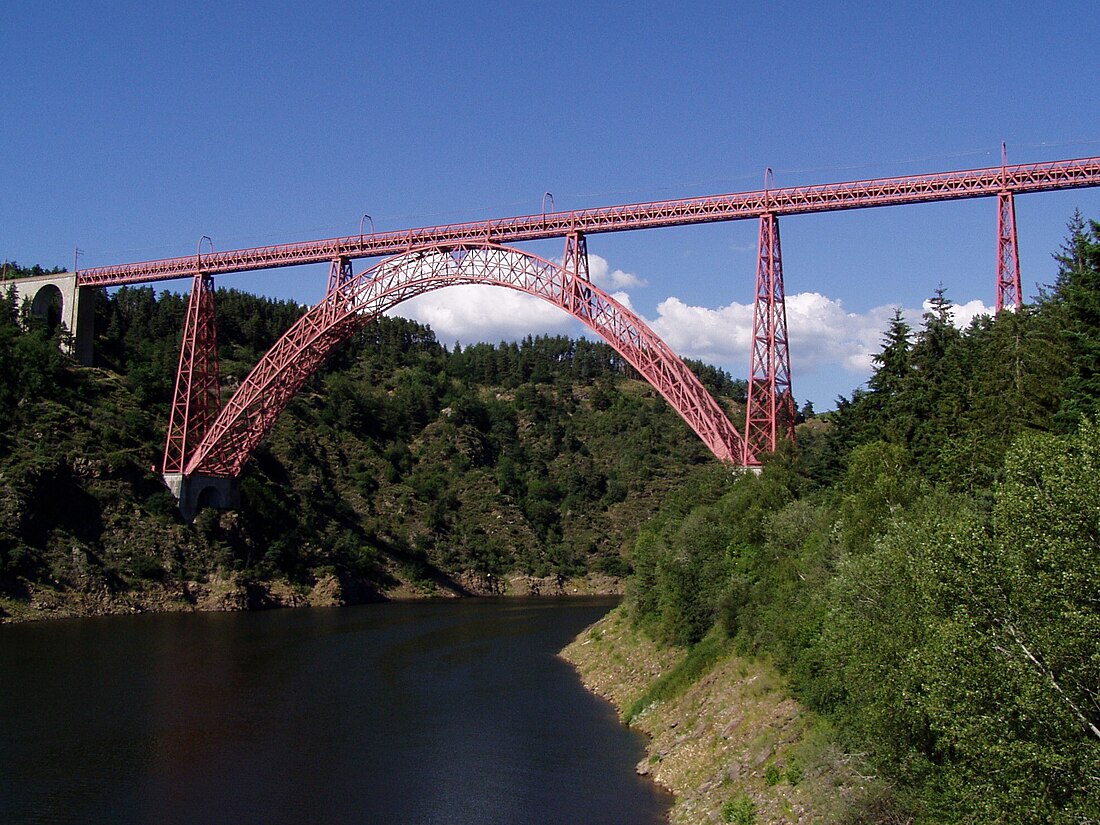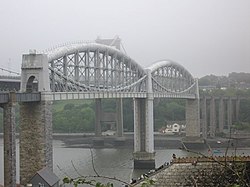Top Qs
Timeline
Chat
Perspective
Steel bridge
Type of bridge From Wikipedia, the free encyclopedia
Remove ads
A metallic bridge is a bridge with a structure made of metal, typically iron, cast iron, or steel.

History
The first metallic bridge was constructed from cast iron in England. Known as the Iron Bridge, it was built in 1779 by Abraham Darby III over the River Severn at Coalbrookdale. The bridge has a span of 30.5 metres (100 ft) and a total length of 60 metres (200 ft), standing 30 metres (98 ft) above the river.[1]
In France, the first metallic bridge was the Pont des Arts in Paris, constructed in 1803 by Louis-Alexandre de Cessart and Jacques Dillon. The pinnacle of cast iron bridges was reached with the Pont du Carrousel, built in Paris in 1834 by Antoine-Rémy Polonceau.[2]
Suspension bridges made of iron began to develop in the United States in 1810.[3] The widespread use of metallic bridges grew with advancements in steel production techniques, coinciding with the expansion of railway networks. This golden age of metallic bridges continued until World War I, despite the emergence of reinforced concrete in France by 1898.[4]
Remove ads
Materials
The steels used in bridge construction are low-alloy iron-carbon alloys. For aesthetic or safety reasons, other steel types, such as Corten steel or stainless steel, may be used.[5]
For safety, steel in bridges is designed to operate well below its yield strength. Material fatigue limits stresses to approximately half the yield strength, around 120 megapascals (17,000 psi) for mild steel and 180 megapascals (26,000 psi) for high-strength steel. Fatigue strength is a critical factor in structural calculations.[5] Other factors, such as temperature, stress corrosion cracking, and performance in saline environments, also influence material selection.[6]
Remove ads
Profiles
Steel profiles used in bridges include:
Common profiles include angle iron, U-shaped beams, and T-beams.[7]
- Unequal angle iron
- I-beam
- U-shaped beam
Assembly methods
Steel assembly methods include bolting, riveting, and welding.[2]
Bolts and rivets secure components through clamping force. Bolts, installed cold, are used for temporary assemblies or in cases where rivets are unsuitable. A bolt consists of a forged head, a threaded shank, and a movable nut screwed onto the threaded portion.[2]
Rivets, installed hot, were historically the primary assembly method in structural steelwork. A rivet has a factory-made head and a shank; the second head is formed by forging the protruding shank while hot, creating a strong clamping force upon cooling.[7]
Welding joins steel by melting and fusing components using coated steel rods (electrodes) that melt under the high temperature of an electric arc. Modern metallic bridges are typically welded, with rivets largely obsolete. Bolts remain in use for emergency bridges, which are assembled rapidly from prefabricated parts.[6]
Remove ads
Metallic beams
Metallic beams typically have an I-shaped profile, though U-shaped or box-section profiles are used when height is limited.[5]
Solid web beams
Solid web beams consist of one or more vertical webs and horizontal flanges (or wings) on either side. These beams can be hot-rolled (I-beams for smaller sizes) or assembled cold from flat plates through welding (welded reconstituted beams, or PRSs) or, historically, riveting with angle irons.[2]
Flanges, with or without angle irons, form the beam’s chords in welded or rolled structures.[2]
- Riveted solid web beam
- Riveted U-shaped beam
- Riveted box-section beam
- Welded reconstituted beam
Truss beams
Truss beams, or triangulated beams, consist of chords connected not by a web but by vertical or inclined bars forming a triangulated framework. The arrangement of bars varies depending on the triangulation system used.[6]
Common truss systems include:
- Pratt truss
- Town truss
- Double Town truss
- K truss
- Warren truss
- Warren truss with verticals
- Howe truss
- Cross of Saint Andrew (Pratt and Howe combination)
- Compound truss
- Vierendeel truss (non-triangulated)
Remove ads
Beam connections
Riveted connections

Riveted connections were standard before welding became prevalent. Both straight beam and truss bridges used rivets. A typical truss connection includes vertical and horizontal members made of angle irons and plates riveted together, with inclined members using U-shaped beams. Cover plates, or gussets, are added at joints to enhance rigidity.[7]
Welded connections

Modern metallic connections typically involve welding, as seen in solid web beams. A transverse beam, or cross-girder, is welded to a longitudinal beam, or stringer. Vertical stiffeners, often terminating in a gusset, reinforce the assembly.[6]
Remove ads
Types of metallic bridges
Straight beam bridges
Depending on the beam structure, these include single box girder bridges (with voussoirs), twin-girder bridges, ribbed bridges, lenticular bridges, and truss bridges.[3]
Suspension bridges
In a suspension bridge, the beam is called the stiffening girder, typically made of a metallic truss.[3]

Three parameters define a suspension bridge:
- Its span, equal to its length (L) for a single-span bridge without approach spans.
- Its sag (f), the distance between the midpoint of the chord connecting the pylon tops and the midpoint of the suspension cable.
- The height (H) of the stiffening girder, typically between L/80 and L/100.
For small to medium spans, the relationship between span and sag is generally [8]
Remove ads
Detailed classification
Remove ads
See also
References
Bibliography
Wikiwand - on
Seamless Wikipedia browsing. On steroids.
Remove ads



















